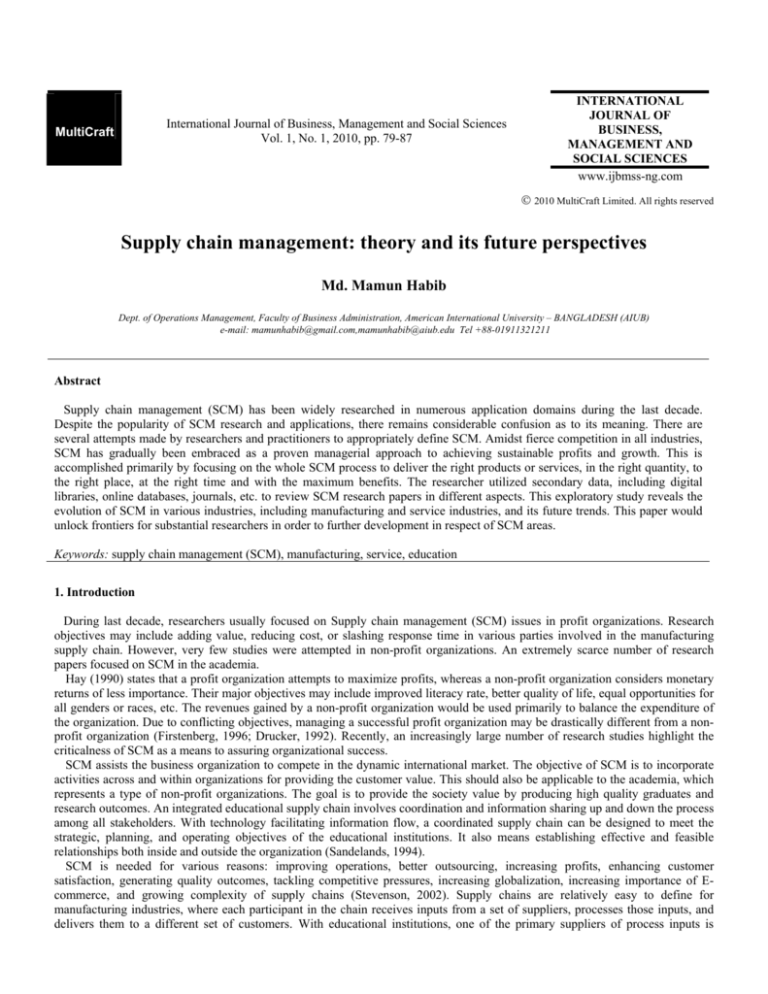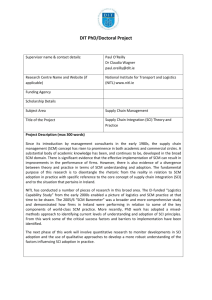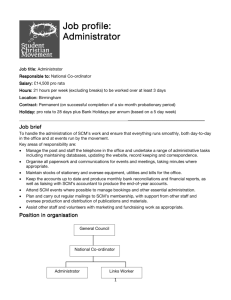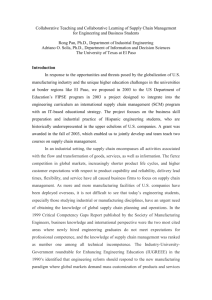
International Journal of Business, Management and Social Sciences
Vol. 1, No. 1, 2010, pp. 79-87
MultiCraft
INTERNATIONAL
JOURNAL OF
BUSINESS,
MANAGEMENT AND
SOCIAL SCIENCES
www.ijbmss-ng.com
© 2010 MultiCraft Limited. All rights reserved
Supply chain management: theory and its future perspectives
Md. Mamun Habib
Dept. of Operations Management, Faculty of Business Administration, American International University – BANGLADESH (AIUB)
e-mail: mamunhabib@gmail.com,mamunhabib@aiub.edu Tel +88-01911321211
Abstract
Supply chain management (SCM) has been widely researched in numerous application domains during the last decade.
Despite the popularity of SCM research and applications, there remains considerable confusion as to its meaning. There are
several attempts made by researchers and practitioners to appropriately define SCM. Amidst fierce competition in all industries,
SCM has gradually been embraced as a proven managerial approach to achieving sustainable profits and growth. This is
accomplished primarily by focusing on the whole SCM process to deliver the right products or services, in the right quantity, to
the right place, at the right time and with the maximum benefits. The researcher utilized secondary data, including digital
libraries, online databases, journals, etc. to review SCM research papers in different aspects. This exploratory study reveals the
evolution of SCM in various industries, including manufacturing and service industries, and its future trends. This paper would
unlock frontiers for substantial researchers in order to further development in respect of SCM areas.
Keywords: supply chain management (SCM), manufacturing, service, education
1. Introduction
During last decade, researchers usually focused on Supply chain management (SCM) issues in profit organizations. Research
objectives may include adding value, reducing cost, or slashing response time in various parties involved in the manufacturing
supply chain. However, very few studies were attempted in non-profit organizations. An extremely scarce number of research
papers focused on SCM in the academia.
Hay (1990) states that a profit organization attempts to maximize profits, whereas a non-profit organization considers monetary
returns of less importance. Their major objectives may include improved literacy rate, better quality of life, equal opportunities for
all genders or races, etc. The revenues gained by a non-profit organization would be used primarily to balance the expenditure of
the organization. Due to conflicting objectives, managing a successful profit organization may be drastically different from a nonprofit organization (Firstenberg, 1996; Drucker, 1992). Recently, an increasingly large number of research studies highlight the
criticalness of SCM as a means to assuring organizational success.
SCM assists the business organization to compete in the dynamic international market. The objective of SCM is to incorporate
activities across and within organizations for providing the customer value. This should also be applicable to the academia, which
represents a type of non-profit organizations. The goal is to provide the society value by producing high quality graduates and
research outcomes. An integrated educational supply chain involves coordination and information sharing up and down the process
among all stakeholders. With technology facilitating information flow, a coordinated supply chain can be designed to meet the
strategic, planning, and operating objectives of the educational institutions. It also means establishing effective and feasible
relationships both inside and outside the organization (Sandelands, 1994).
SCM is needed for various reasons: improving operations, better outsourcing, increasing profits, enhancing customer
satisfaction, generating quality outcomes, tackling competitive pressures, increasing globalization, increasing importance of Ecommerce, and growing complexity of supply chains (Stevenson, 2002). Supply chains are relatively easy to define for
manufacturing industries, where each participant in the chain receives inputs from a set of suppliers, processes those inputs, and
delivers them to a different set of customers. With educational institutions, one of the primary suppliers of process inputs is
80
Md. Mamun Habib / International Journal of Business, Management and Social Sciences, Vol. 1, No. 1, 2010, pp. 79-87
customers themselves, who provide their bodies, minds, belongings, or knowledge as inputs to the service processes (Habib and
Jungthirapanich, 2009).
This exploratory study reveals the following objectives:
• Analysis the overview of SCM through different citations.
• Review extensive literature reviews regarding SCM based on secondary data.
• Define the SCM and the evolution of SCM.
• Analysis the trends of SCM and its future perspectives.
2. Literature Review
The term, “supply chain management,” has risen to eminence over the last ten years. About 13.55% of the concurrent session
titles contained the words “supply chain” at the 1995 Annual Conference of the Council of Logistics Management. The number of
sessions containing the term rose to 22.4% at the 1997 conference, just two years later. The term is commonly used to illustrate
executive responsibilities in corporations (La Londe, 1997). SCM has become such a “hot topic” that it is difficult to pick up a
periodical on manufacturing, distribution, marketing, customer management, or transportation without seeing any article about
SCM or SCM-related topics (Ross, 1998).
Some authors defined SCM in operational terms involving the flow of materials and products, some viewed it as a management
philosophy, and some viewed it in terms of a management process (Tyndall et al., 1998), some viewed it as integrated system.
Authors have even conceptualized SCM differently within the same article: as a management philosophy on the one hand, and as a
form of integrated system between vertical integration and separate identities on the other hand (Cooper and Ellram, 1993).
According to Christopher (1994), a supply chain is “a network of organizations that are involved, through upstream and
downstream linkages, in the different processes and activities that produce value in the form of products and services in the hands
of the ultimate customer.” An example of a basic supply chain is shown in Figure 1.
Figure 1. The Basic Supply Chain (Chopra and Meindl, 2001)
The supply chain includes suppliers, manufacturers, distributors, retailers, and customers. The customers are the main focus of
the chain, since the primary purpose of the existence of any supply chain is to satisfy customer needs, in the process generating
profit for itself (Chopra and Meindl, 2001). SCM was initially related to the inventory management within a supply chain. This
concept was later broadened to include management of all functions within a supply chain. According to Chopra and Meindl
(2001), “SCM engages the management of flows between and among stages in a supply chain to minimize total cost”. This
definition implies that SCM involves management of flows of products, information, and finance upstream and downstream in the
supply chain.
In the course of time, the most considerable benefits to businesses with advanced SCM capabilities will be radically improved
customer responsiveness, developed customer service and satisfaction, increased flexibility for changing market conditions,
improved customer retention and more effective marketing (Horvath, 2001).
SCM is a concept, “whose primary objective is to integrate and manage the sourcing, flow, and control of materials using a total
systems perspective across multiple functions and multiple tiers of suppliers” (Monczka, Trent and Handfield, 1994). Stevens
(1989) stated the objective of SCM was to synchronize the customers’ requirements with materials flow to strike a balance among
conflicting goals of maximum customer service, minimum inventory management, and low unit costs.
The supply chain is viewed as a single process. Responsibility for the different divisions in the chain is not fragmented and
transferred to functional areas such as manufacturing, purchasing, distribution, and sales. SCM calls for, and in the end depends
on, strategic decision-making. “Supply” is a shared objective of practically every function in the chain and is of particular strategic
importance because of its impact on overall costs, profits and market share. SCM calls for a different point of view on inventories
that are utilized as a balancing mechanism of last, not first, resort. A latest approach to systems is required - integration rather than
interfacing (Houlihan, 1988).
SCM is delivering major economic benefits to businesses as diverse as manufacturing, retail, and service organizations, etc.
(Horvath, 2001). The scope of SCM was further expanded to include re-cycling (Baatz, 1995). SCM deals with the total flow of
materials from suppliers through end users (Jones and Riley, 1985). It highlights “total” integration of all stakeholders within the
81
Md. Mamun Habib / International Journal of Business, Management and Social Sciences, Vol. 1, No. 1, 2010, pp. 79-87
supply chain, a realistic approach is to consider only strategic suppliers and customers since most supply chains are too complex to
attain full integration of all the supply chain entities (Tan et al., 1998).
Supply chain strategy includes “two or more firms in a supply chain entering into a long-term agreement; the development of
mutual trust and commitment to the relationship; the integration of logistics events involving the sharing of demand and supply
data; the potential for a change in the locus of control of the logistics process” (La Londe and Masters, 1994). Manufacturers are
able to develop alternative conceptual solutions, select the best components and technologies, and assist in design assessment by
involving suppliers early in the design stage, (Burt and Soukup, 1985).
SCM incorporates logistics into the strategic decisions of the business (Carter and Ferrin, 1995). Eventually, the philosophy
developed and combined into a common body of knowledge that encompassed all the value-adding activities of the manufacturers
and logistics providers (Tan, 2001). Many SCM strategic models have been investigated to link its vital role in overall strategic
corporate planning (Frohlich et al., 1997; Watts et al., 1992). Experts agree that a formal supply chain strategy will be critical to
both manufacturing and service industries (Kathawala, 2003).
Such ambiguity suggests a need to examine the phenomena of SCM more closely to define clearly the term and concept, to
identify those factors that contribute to effective SCM, and to suggest how the adoption of an SCM approach can affect corporate
strategies, plans, operations and performance.
Proper performance measures and metrics including activity-based costing and management may be helpful in identifying nonvalue-adding activities across a supply chain. Total Quality Management (TQM) methods can be utilized to eradicate these
inefficiencies, thereby improving the overall effectiveness of a supply chain. Customer demands and supply chain relationships are
the key in selecting the most appropriate method of target costing for supply chains. Activity-based, process-based, value-based
and cost management approaches may be fit for TQM in SCM (Lockamy and Smith, 2000).
2.1 Definitions of SCM
American Production and Inventory Control Society (APICS, 1990) define the supply chain as the processes from the initial raw
materials to final consumption of the finished products linking across supplier-user industries. The supply chain constitutes all
functions within and outside an industry, which enable the value chain to make products and provide services to customers (Inman,
1992). Some researchers suggested a clearer SCM definition by adding the information system necessary to monitor all of the
activities (Lee, 2002; Morgan, 1995; Srinivas, 2002).
Recently, the Council of SCM Professionals (CSCMP), which is the premier organization of supply chain practitioners,
researchers, and academicians, has defined SCM as: “SCM encompasses the planning and management of all activities involved in
sourcing and procurement, conversion, and all Logistics Management activities. Importantly, it also includes coordination and
collaboration with channel partners, which can be suppliers, intermediaries, third-party service providers, and customers. In
essence, SCM integrates supply and demand management within and across companies” (Ballou, 2007).
Scott and Westbrook (1991) described SCM as the chain linking each element of the manufacturing and supply process from
raw materials to the end user. This management philosophy focused on how firms utilized their suppliers’ processes, technology,
information, and capability to enhance competitive advantage (Farley, 1997), and the coordination of the manufacturing, materials,
logistics, distribution and transportation functions within an organization (Lee and Billington, 1992). SCM is an integrative
philosophy to manage the total flow of a distribution channel from supplier to the ultimate user (Cooper et al., 1997).
Supply chain is defined as all the activities involved in delivering a product from raw materials to the customer including
sourcing raw materials and parts, manufacturing and assembly, warehousing and inventory tracking, order entry and order
management, distribution across all channels, delivery to the customer, and the information systems necessary to monitor all of
these activities. SCM coordinates and integrates all of these activities into a seamless process. It links all of the stakeholders in the
chain including parties within an organization and the external partners including suppliers, carriers, third party companies, and
information systems providers (Lummus, 1999).
SCM is defined as the systemic, strategic coordination of the traditional business functions and the tactics across these business
functions within a particular organization and across businesses within the supply chain, for improving the long-term performance
of the individual organization and the supply chain as a whole (Mentzer and et al., 2001).
Most of the recent SCM literature focused on the purchasing function, stating that it was a basic strategic business process,
rather than a specialized supporting function (Wisner and Tan, 2000). It was a management philosophy that extended traditional
internal activities by adopting an inter-enterprise scope, allowing trading partners together with the common goal of optimization
and efficiency (Harwick, 1997).
The customized definition for the service industry is as follows: The SCM for the service industry is the ability of the
company/firm to get closer to the customer by improving its supply chain channels. The services supply chain will include
responsiveness, effectiveness, efficiency, and controlling (Kathawala, 2003). One of the primary suppliers of process inputs is
customers themselves in service organizations. This concept of customers being suppliers is recognized as ‘customer-supplier
duality.’ The duality implies that service supply chains are bi-directional (Sampson, 2000). The concept may be applicable to the
academia as well.
Integrated SCM is about going from the external customer and then managing all the processes that are needed to provide the
customer with value in a horizontal way (Monczka and Morgan, 1997). Generally, SCM comprises integrated functions from raw
82
Md. Mamun Habib / International Journal of Business, Management and Social Sciences, Vol. 1, No. 1, 2010, pp. 79-87
materials to final products. It also covers integrated management of every organization throughout the whole chain (Horvath,
2001; Srinivas, 2002). An analysis of SCM for manufacturing illustrates the integrated processes required for managing goods
from the initial source of supply to point of consumption. It also includes a wide range of activities that material and service
suppliers, manufacturers, wholesalers, and retailers have performed for years. Each supply chain participants manage to enhance
performance of their own enterprises. Very little concentration is given to the benefits of managing the total supply chain process
on an integrated basis (Closs, 1995).
SCM, as applied to manufacturing, has been defined differently. These varieties of definitions often carry through to the extent
that the key people in the same organization are not speaking about the same things, when they discuss the concept of SCM
(Monczka and Morgan, 1997).
First, there are definitions characterized by the simplest concepts of SCM, one is “the ability to get closer to the customer”
(Weil, 1998). Another is that the supply chain is the flow of information and material from suppliers to customers (Crom, 1996). A
company’s supply chain, either internal or external, is a resource to be exploited for better market position and enhanced
competitive advantage. Strategic use of this resource requires that companies do the following (Monczka and Morgan, 1997):
(1)
Gain a closer understanding of their customer’ and future customers’ needs, both nationally and internationally;
(2)
Understand their suppliers’ core competencies in meeting customer needs;
(3)
Determine where redundancies and inefficiencies lie within the supply chain in relation to current and future
competitive needs;
(4)
Develop relationships and alliances with suppliers who have key competencies that strengthen, supplement, and
enhance internal core competencies nationally and internationally.
SCM, from the viewpoint of a manufacturing sector, may be defined as “taking control of all goods within the supply chain, all
materials, no matter how to handle or manage (Sandelands, 1994).” In particular, SCM is the process of effectively managing the
flow of materials and finished goods from retailers to customers using the manufacturing facilities and warehouses as potential
intermediate steps (Sengupta and Turnbull, 1996).
2.2 Evolution of SCM
The supply chain literature review was conducted to study the past researches. Before the 1950s, logistics was thought of in
military terms (Ballou, 1978). It had to do with procurement, maintenance, and transportation of military facilities, materials, and
personnel. The study and practice of physical distribution and logistics emerged in the 1960s and 1970s (Heskett et al., 1973).
The logistics era prior to 1950 has been characterized as the “dormant years,” when logistics was not considered a strategic
function (Ballou, 1978). Around 1950s changes occurred that could be classified as a first “Transformation.” The importance of
logistics increased considerably, when physical distribution management in manufacturing firms was recognized as a separate
organizational function (Heskett et al., 1964). The SCM concept was coined in the early 1980s by consultants in logistics (Oliver
and Webber, 1992). The authors emphasized that the supply chain must have been viewed as a single entity and that strategic
decision-making at the top level was needed to manage the chain in their original formulation. This perspective is shared with
logisticians as well as channel theorists in marketing (Gripsrud, 2006).
SCM has become one of the most popular concepts within management in general (La Londe, 1997) since its introduction in the
early 1980s (Oliver and Webber, 1992). A number of journals in manufacturing, distribution, marketing, customer management,
transportation, integration, etc. published articles on SCM or SCM-related topics. The evolution of SCM continued into the 1990s
due to the intense global competition (Handfield, 1998). Berry (1994) defined SCM in the electronics industry.
Drucker (1998) went as far as claiming there was a paradigm shift within the management literature: “One of the most
significant changes in paradigm of modern business management is that individual businesses no longer compete as solely
autonomous entities, but rather as supply chains. Business management has entered the era of inter-network competition and the
ultimate success of a single business will depend on management’s ability to integrate the company’s intricate network of business
relationships.”
Fernie (1995) adopted SCM in the National Health Service. Sampson (2000) explored the customer supplier duality in the
service organizations as it pertained to SCM in the service industry. Kathawala and Abdou (2003) explored supply chain
application to the service industry. O’Brien and Kenneth (1996) proposed an educational supply chain as a tool for strategic
planning in tertiary education. The study was based on a survey among employers and students. Survey findings revealed that
integration and coordination among students and employers should have been promoted. Cigolini et al. (2004) explored a
framework for SCM based on several service industries including automobile, grocery, computers, book publishing etc. According
to the case study conducted at the City University of Hong Kong, Lau (2007) defined educational supply chain as the ‘Student’ and
the ‘Research’ supply chain.
Habib (2009) represents the first large scale empirical study that systematically investigate input of the university, output of the
university through educational SCM. This exploratory research addresses the education supply chain, the research supply chain,
and educational management as major constituents in an Integrated Tertiary Educational Supply Chain Management (ITESCM)
model (Habib and Jungthirapanich, 2010). Its applicability was successfully verified and validated through survey data from
leading tertiary educational institutions around the world (Habib, 2010).
83
Md. Mamun Habib / International Journal of Business, Management and Social Sciences, Vol. 1, No. 1, 2010, pp. 79-87
The emergence and evolution of SCM may be depicted as a timeline shown in Figure 2:
1980
1995
Initiated the SCM concept.
Initiated SCM in the Service Industry.
1950
Initiated logistic concept.
1970
Matured logistic concept
1950 - 1970
1970 - 1980
Logistic in SCM
1980 - 1990
1990 - 2008
SCM in the Manufacturing Industry.
1985
Educational SCM
2007
Figure 2. Evolutionary Timeline of SCM (Habib and Jungthirapanich, 2008)
3. Research Methodology
The analysis of this research is based on secondary data, including online databases, digital libraries, books, journals, conference
papers, etc. Extensive SCM research papers of academicians and practitioners are evolved from renowned international journals,
namely PROQUEST, EMERALD, EBSCO, IEEE, ACM, JSTOR, Science Direct, etc. Evolutionary timeline and future trends
were developed based on the analysis of literature. The author classifies SCM in different areas of Manufacturing and Service
industries.
4. Results and Discussion
From all of the above discussions, different citations for the SCM in this research have been summarized in Table 1. This
summary described in different SCM aspects in different papers, articles. In this table, SCM is mainly classified into the
manufacturing or the service industry. Research studies on SCM in the manufacturing industry are focused in different areas.
Based on the citations and definitions, these areas are material flow, integrative, strategic, management, others including inventory,
flow of orders, information flow, finished goods flow, coordination, planning, goods progress, networking, design assessment,
chain link, recycling, competitive advantage, performance, collaboration, aerospace, and quality. SCM in the service industry is
classified into general and education areas. In this study, the researcher focused on sixty (60) references on SCM in the
manufacturing and the service industry. Among them, fifty two (52) citations are related to SCM in the manufacturing industry.
Eight (8) papers, two of which aim at SCM in education, are relevant to the service industry. Only one research relates to both
manufacturing and service sectors.
Table 1. A Summary of SCM Citations in Manufacturing and Service Industries
Citations
Jones and Riley, 1985
Burt and Soukup, 1985
Houlihan, 1988
Stevens, 1989
Jones, 1989
Scott and Westbrook, 1991
Inman, 1992
Lee and Billington, 1992
Watts et al., 1992
Cooper and Ellram, 1993
Sandelands, 1994
Christopher, 1994
La Londe et al., 1994
Monczka et al., 1994
Berry, 1994
Fernie, 1995
Closs, 1995
Carter and Ferrin, 1995
Baatz, 1995
Morgan, 1995
Crom, 1996
Sengupta and Turnbull, 1996
Material Flow
#
Manufacturing
Integrative Strategic
#
Mgt.
Others
#
Design
Assessment
Inventory
#
Flow of Orders
Chain Link
Value Chain
Coordination
Planning
#
#
#
Service
General
Education
#
#
Networking
#
#
#
#
#
#
#
#
#
#
#
Recycling
Inform. System
Information Flow
Finished Goods
Flow
84
Md. Mamun Habib / International Journal of Business, Management and Social Sciences, Vol. 1, No. 1, 2010, pp. 79-87
Table 1(cont’d). A Summary of SCM Citations in Manufacturing and Service Industries
Citations
Material Flow
Manufacturing
Integrative Strategic
Mgt.
Others
O’Brien and Kenneth, 1996
Farley, 1997
Frohlich et al., 1997
Monczka and Morgan, 1997
Cooper et al., 1997
Harwick, 1997
Tyndall et al., 1998
Drucker, 1998
Tan et al., 1998
Weil, 1998
Lummus, 1999
Gilmour, 1999
Tan, 1999
Sampson, 2000
Wisner and Tan, 2000
Wisner and Tan, 2000
Stank, 2000
Tan, 2001
Chopra and Meindl, 2001
Horvath, 2001
Mentzer et al., 2001
Tan, 2002
Lee, 2002
Stevenson, 2002
Srinivas, 2002
Kathawala, 2003
Bales, 2004
Cigolini et al., 2004
Zailani, 2005
Samaranayake, 2005
Power, 2005
Tummala et al., 2006
Kim, 2006
Sila et al., 2006
Ballou, 2007
Lee, 2007
Lau, 2007
Habib and Jungthirapanich, 2009
Service
General
Education
#
Competitive
Advantage
Planning
#
#
#
#
#
#
#
#
#
#
#
#
#
Coordination
Performance
#
#
#
Transportation
#
#
Collaboration
Coordination
#
#
#
Inform. System
Goods Progress
Inform. System
#
#
#
Aerospace
#
#
#
#
Performance
#
#
#
Assessment
Performance
Quality
Planning
Performance
#
#
A comparative analysis of SCM in different aspects, including manufacturing industries and service industries, is identified in
this reserach. Figure 3a depicts SCM in manufacturing industries and service industries including educational institutions. On the
other hand, Figure 3b focused SCM in manufacturing industries, service industries excluding educational institutions, and
education.
Figure 3a. A Comparative Analysis of SCM in Different Aspects
85
Md. Mamun Habib / International Journal of Business, Management and Social Sciences, Vol. 1, No. 1, 2010, pp. 79-87
Figure 3b. A Comparative Analysis of SCM in Different Aspects
5. Conclusion
From the above mentioned Table 1, Figure 3a and 3b, it is quite clear that, few (13%) and very few researchers (5%) conducted
SCM in the service industries and education respectively. Most of them (87%) conducted SCM in the manufacturing industries. It
seems to be that SCM in the educational institutions needs more to be explored in the future.
It is a surprising fact that researchers develop supply chain models mostly for improving business operations. Few, particularly
academic researchers, do not realize that the research on academic SCM may also be conducted for their own educational
institutions. The performance of the SCM depends on the seamless coordination of all supply chain stakeholders to ensure
attainment of desirable outcomes. This research is based on only secondary data, though it is the limitation of this paper, however,
this study would unlock frontiers for substantial researchers in order to further development in respect of supply chain
management arena.
References
Baatz, E.B., 1995. CIO100-best practices: the chain gang, CIO, Vol.8 No.19, pp.46-52.
Ballou, Ronald H., 2007. The evaluation and future of logistics and supply chain management, European Business Review, Vol.19
No.4, pp. 332-348
Ballou, R., 1978. Basic Business Logistics, Prentice-Hall, Englewood Cliffs, NJ.
Berry, D.R. Towill and N. Wadsley, 1994. Supply chain management the electronics products industry, International Journal of
Physical Distribution & Logistics Management, Vol. 24, No. 10, pp. 20-32.
Burt, D.N. and Soukup, W.R., 1985. Purchasing’s role in new product development, Harvard Business Review, Vol. 64, No.5,
pp. 90-7
Carter, J.R. and Ferrin, B.G., 1995. The impact of transportation costs on supply chain management, Journal of Business Logistics,
Vol.16, No.1, pp. 189-212.
Cigolini, R., M. Cozzi and M. Perona, 2004. A new framework for supply chain management, International Journal of Operations
& Production Management, Vol. 24, No. 1, pp. 7-41.
Closs, D. J, 1995. Enhance supply chain effectiveness, Transportation & Distribution, April, Vol. 36, No.4, pp.82.
Crom, S., 1996. De –fuse multi-cultural clashes, Transportation & Distribution, July, Vol. 37, No.7, pp.84.
Cooper, M., Ellram L.M., Gardner J.T., and Hanks A.M., 1993. Meshing multiple alliances, Journal of Business Logistics, Vol. 18,
No. 1, pp. 67-89.
Cooper, M.C., Lambert D.M., and Pagh J.D., 1997. Supply chain management: more than a new name for logistics, The
International Journal of Logistics Management, Vol. 8, No. 1, pp. 1-14.
Christopher, M., 1994. Logistics and Supply Chain Management, Pitman Publishing, New York, NY.
Chopra, S. and Meindl, P., 2001. Supply Chain Management, Prentice Hall, NJ.
Drucker, P.F., 1998. Practice of Management, Butterworth Heinemann, Oxford.
Farley, G.A., 1997. Discovering supply chain management: a roundtable discussion, APICS - The Performance Advantage, Vol.7
No.1, pp. 38-9.
Fernie, J. and Rees C., 1995. Supply chain management in the national health service, The International Journal of Logistics
Management, Vol. 6, No. 2, pp. 83-92.
86
Md. Mamun Habib / International Journal of Business, Management and Social Sciences, Vol. 1, No. 1, 2010, pp. 79-87
Firstenberg, P.B., 1996. The 21st Century Nonprofit: Remarking the Organization in the Post-Government Era, The Foundation
Center, New York, NY.
Frohlich, M., Dixon, J.R. and Arnold, P., 1997. A taxonomy of supply chain strategies, Proceedings of the 28th Annual Meeting of
the Decision Sciences Institute, San Diego, CA.
Gripsrud, G. 2006. Suuply chain management-back to the future? International Journal of Physical Distribution & Logistics
Management, Vol. 36 No. 8, pp.643-659.
Habib, M. and Jungthirapanich C., 2008. An integrated framework for research and education supply chain for the universities,
Proceedings of the 4th IEEE International Conference on Management of Innovation and Technology, IEEE Computer Society,
Piscataway, USA, Sep., pp. 1027-1032
Habib, M., 2009. An Integrated Educational Supply Chain Management (ITESCM)”, Ph.D. Dissertation, Graduate School of
Information Technology, Assumption University of Thailand, December.
Habib, M. and Jungthirapanich, C., 2009. Research Framework of education supply chain, research supply chain and educational
management for the universities, International Journal of the Computer, the Internet and Management (IJCIM), Thailand, Vol
17, No. SP1, pp.24.1-8.
Habib, M. and C. Jungthirapanich, 2010. An Empirical Research of Educational Supply Chain for the Universities, The 5th IEEE
International Conference on Management of Innovation and Technology, Singapore, June.
Habib, Mamun, 2010. An Empirical Research of ITESCM (Integrated Tertiary Educational Supply Chain Management) Model
Editor, Management and Services, Sciyo.com, October, ISBN 978-953-307-118-3
Hay, R.D., 1990. Strategic Management in Non-Profit Organizations: An Administrator’s Handbook, Quorum Books, Westport,
CT.
Handfield Robert B., Kannan Vijay R., Tan Keah Choon, 1998. Supply chain management: supplier performance and firm
performance, International Journal of Purchasing and Materials Management, AZ USA, pp.2-9, Aug.
Heskett, J., Ivie, R. and Glaskowsky, N., 1964. Business Logistics, Management of Physical Supply and Distribution, the Ronald
Press Company, New York, NY.
Heskett, J.L., Glaskowsky,N.A. Jr and Ivie, R.M., 1973. Business Logistics, 2nd ed., The Ronald Press, New York, NY, pp.14-21.
Horvath, Laura, 2001. Collaboration: the key to value creation in supply chain management, Supply Chain Management: An
International Journal, Vol. 6 No. 5, pp. 205-207.
Houlihan, J.B., 1988. International supply chains: a new approach, Management Decision, Vol. 26, No. 3, pp. 13-19.
Harwick, T., 1997. Optimal decision-making for the supply chain, APICS - The Performance Advantage, Vol.7 No. 1, pp. 42-4.
Inman, R.A. and Hubler J.H, 1992. Certify the process – not just the product, Production and Inventory Management Journal, Vol.
33, No. 4, pp. 11-14.
Jones, T. and Riley D.W., 1985. Using inventory for competitive advantage through supply chain management, International
Journal of Physical Distribution and Materials Management, Vol. 15, No. 5, 1985, pp. 16-26.
Kathawala, Y. and Abdou K., 2003. Supply chain evaluation in the service industry: a framework development compared to
manufacturing”, Managerial Auditing Journal, Vol. 18, No. 2, pp.140-149.
Lockamy, A. and Smith, W.I., 2000. Target costing for supply chain management: criteria and selection, Industrial Management &
Data Systems, Vol.100, No. 5, pp. 210-8.
Lau, Antonio K.W, 2007. Educational supply chain management: a case study, Emerald Group Publishing Limited, ISSN 10748121, Vol. 15 No.1, 2007, pp.15-27
La Londe, B. J., 1997. Supply chain management: myth or reality? Supply Chain Management Review, Vol. 1, Spring, pp. 6-7.
La Londe, B. J. and Masters J.M., 1994. Emerging logistics strategies: blueprints for the next century, International Journal of
Physical Distribution and Logistics Management, Vol. 24, No. 7, pp. 35-47.
Lee, H.L. and Billington, C., 1992. Managing supply chain inventory: pitfalls and opportunities, Sloan Management Review, Vol.
33 No.3, pp.65-73.
Lee C. B., 2002. Demand Chain Optimization – Pitfalls and Key Principles, USA, Nonstop Solution.
Lummus, R. and Vokurka R.J., 1999. Defining supply chain management: a historical perspective and practical guidelines,
Industrial Management & Data Systems, Vol. 99, No.1, pp.11-17.
Mentzer, John T., 2001. Defining supply chain management, Journal of Business Logistics, Vol. 22 No. 2, 2001
Monczka, R. M. and Morgan, J., 1997. What’s wrong with supply chain management, Purchasing, 16 January, pp. 69-72.
Monczka, R., Trent R., and Handfield R., 1994. Purchasing and Supply Chain Management, Cincinnati, OH: South-Western
College Publishing, Chapter 8.
Morgan J. and Monczka R.M., 1995. Alliances for New Products, Purchasing Journal, Vol. 10, No. 1, pp. 103-109.
Oliver, R.K. and Webber, M.D., 1992. Supply-chain management: logistics catches up with strategy, in Christopher, M. (Ed.),
Logistics: The Strategic Issues, Chapman & Hall, London.
O’Brien, Elaine M. and Kenneth R., 1996. Educational supply chain: a tool for strategic planning in tertiary education?, Marketing
Intelligence & Planning, Vol. 14, No. 2, pp.33-40.
Ross, D. F., 1998. Competing Through Supply Chain Management, New York, NY: Chapman & Hall.
87
Md. Mamun Habib / International Journal of Business, Management and Social Sciences, Vol. 1, No. 1, 2010, pp. 79-87
Sampson, Scott E., 2000. Customer-supplier duality and bidirectional supply chains in service organization, International Journal
of Service Industry Management, Vol. 11, No. 4, pp.348-364.
Sandelands, E., 1994. Building supply chain relationships, International Journal of Physical Distribution & Logistics
Management, Vol. 24 No. 3, pp.43-4.
Scott, C. and Westbrook, R., 1991. New strategic tools for supply chain management, International Journal of Physical
Distribution & Logistics Management, Vol. 21 No. 1, pp. 23-33.
Sengupta, S. and Turnbull, J. 1996. Seamless optimization of the entire supply chain, IIE Solutions, Vol. 28, No. 10, pp.28-33.
Srinivas T., 2002. Enhancing supply decisions through the use of efficient marginal cost models, The Journal of Supply Chain
Management, pp. 4-10, Fall.
Stevenson, W.J., 2002. Operations Management, 7th ed., McGraw-Hill/Irwin, NY.
Stevens, G.C., 1989. Integrating the supply chains, International Journal of Physical Distribution and Materials Management,
Vol. 8, No. 8, pp. 3-8.
Tyndall, G., Gopal C., Partsch W., and Kamauff J., 1998. Supercharging Supply Chains: New Ways to Increase Value Through
Global Operational Excellence, NY: John Wiley & Sons.
Tan, K.C., Handfield, R.B. and Krause, D.R., 1998. Enhancing firm’s performance through quality and supply base management:
an empirical study, International Journal of Production Research, Vol. 36, No. 10, pp. 2813-37.
Tan, K.C., 2001. A framework of supply chain management literature, European Journal of Purchasing and Supply Management,
Vol.7 No.1, pp. 39-48.
Watts, C.A., Kim, K.Y. and Hahn, C.K., 1992. Linking purchasing to corporate competitive strategy, International Journal of
Purchasing and Materials Management, Vol. 92, pp. 2-8.
Wisner, J.D. and Tan, K.C., 2000. Supply chain management and its impact on purchasing, Journal of Supply Chain Management,
Vol.36 No.4, pp. 33-42.
Weil, M., 1998. Customize the customer, Manufacturing Systems,Vol.16 No. 4, pp.54-64.
Biographical notes
Dr. Md. Mamun Habib accomplished Ph.D. and M.S in Computer & Engineering Management from Assumption University of Thailand in 2006 and 2009
respectively. He achieved President and Vice-President Award for his outstanding performance in both Ph.D. and Master degree level. He developed a model of
supply chain management for tertiary educational institutions in his doctoral degree level. He performed B.Sc. in Electrical and Electronics Engineering from
Bangladesh University of Engineering & Technology (BUET) in 2002. He is presently working as Assistant Professor in the Operations Management department at
the faculty of Business Administration in American International University – Bangladesh (AIUB). He has about 8 years experience in the field of teaching for
graduate and postgraduate students, training, consultancy and research. As a researcher, he has about 20 research papers and articles in renowned Conferences,
reputed Journals and Book chapters. He is the Editor/Editorial board member/Reviewer of different books, reputed international journals and conferences. He is
also serving as Ph.D. External examiner (Evaluator of Ph.D. Dissertation). His interested research areas are supply chain management, educational management,
production & operations management, engineering management, technology management. He is member of different professional organizations including IEEE,
IEB, AIMS, etc.
Received September 2010
Accepted October 2010
Final acceptance in revised form October 2010










